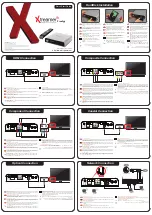
2. Installation of the frequency converter
The frequency converter is equipped with connection terminals, protected from corrosion, dedicated to make
appropriate connections. Additional information about external connections can be found in section 2.1.1 under the
“
Equipotential connections
” and in section 2.1.2. In order to comply with EU directives of electromagnetic compatibility
(EMC), application of a four-wire shielded cable (three earth wire) is recommended to power the motor. The
type of line chokes and protections are available at the manufacturer's representative. Do not use any circuit breakers or
contactors on the output side of the converter that would disconnect the system during its operation - see section 2.3.
2.1.1. Safety rules
a.
Equipotential connections
The protection against indirect touching live parts consists of automatic switching off by special short-circuit
protection (or differential-current protection) or voltage limitation to a level not exceeding acceptable values, in case of
an insulation failure.
The short circuit to ground at the frequency converter output can be not detected by short-circuit protection,
devices due to DC-link circuit. The protection against phase-to-phase and phase-to-ground short-circuit on the output of
the converter is provided. However this protection is based on IGBT transistors blocking, what does not conform to the
requirements of fire-prevention protection. Due to that, for safety of staff, it is necessary to make local equipotential
connections.
In the frequency converter there are provided appropriate terminals, properly marked, protected from corrosion
to make equipotential connections.
b. Protection
The maximum values of input wire short-circuit protection are presented in the table 0.2. It is allowed to use gG
or aM fuses, however taking into account necessity of protection of the rectifier bridge of the frequency converter, the
best solution is gR or aR fuses. You can use overcurrent protection, but the response time of such devices is longer
than properly chosen fuse.
Frequency converter is protected from: drive overloading, motor overheating, under- and overvoltage in an DC
link circuit of the converter, a short-circuit at the converter output (it protects converter only!).
The usage of differential-current protection due to electrical shock prevention can appear unfavourable since it
can trigger due to temporary or constant leakage current of the power drive system, working in normal conditions. In
case of usage of the differential-current protection devices you may use only circuit breakers of a B type, due to different
nature of a differential current.
c.
Disconnecting device
In order to comply with EU directives, according to IEC/EN 60204-1:2010, power drive, which consists of a
frequency converter and electrical machine should be supplied with a device for disconnecting power supply. This
device should be one of listed below:
•
separator (with or without fuses), category of usage AC-23B fulfilling the requirements EN 60947-3,
•
disconnector (with fuses or without), disconnecting a load circuit before opening main contacts, conforming
the EN 60947-3 requirements,
•
tripper conforming the EN 60947-2 requirements.
The installer is responsible for meeting this requirement.
d.
Emergency stop
In order to comply with EU directives and IEC/EN 60204-1:2010 and for personnel safety and equipment, it is
necessary to use an emergency stop switch, which has higher priority than other functions, irrespective of operating
mode. The key STOP on operator panel cannot be treated as the switch of abnormal break, because it doesn't
disconnect a frequency converter from power supply. The installer is responsible for meeting the requirement.
e.
Casing
Cases of converters with a power 37 kW and below meet the requirements of the protection class IP20. The
housings of converters with a power of 45 kW and above have the protection class IP00. In case of individual
implementation, the degree of protection may be different. The surface, on which the operator's control panel is located,
meets the requirements of an IP40 protection degree. The casing has been designed so that it cannot be removed
without the use of tools.
f. C
apacitors discharging
In a DC link circuit of a frequency converter there is a capacitor battery with relatively high capacity. After turning
off of a supply voltage in its clamps dangerous voltage is present for a certain time. It is necessary to wait for 5÷15
minutes (a higher power rating of the frequency converter means the longer time) before making connections on clamps
of power terminal strip of a frequency converter. Before starting any installation works make sure that a voltage on a
clamps is not present. The information about danger of such voltage is placed also on terminal strip cover.
2.1.2. Electromagnetic compatibility (EMC) rules
The installation principles reducing EMC problems are divided into four groups. You can achieve the full effect by
applying all the principles listed below. Not applying any of the rules undermines the effectiveness of the others:
•
separation,
•
equipotential bonding,
•
shielding,
•
filtration.
The basic way of connecting the filter, the frequency
converter and the motor is presented in the figure 2.3.
16
Frequency converter MFC710 type. TWERD Power Electronics
Fig. 2.3 - Connection of separate components of the
electric drive system
















































